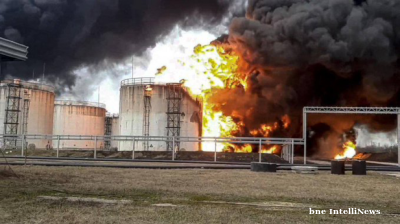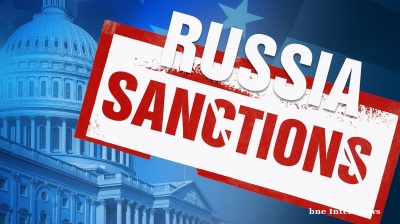BOAK is a Russian anarcho-communist collective inside Russia that has taken up arms and has organised a string of sabotage attacks that target government buildings and place bombs on railway tracks.
Made up of young, educated Russians determined to overthrow Russian President Vladimir Putin, BOAK is fighting against his illegal invasion of Ukraine.
“We think that persons who are responsible for killing or torturing people deserve death. Because killing them means they can’t harm good people anymore,” an anonymous representative of BOAK told bne IntelliNews in an exclusive interview.
“But we have strong moral principles. We are strongly against “random victims”; we always plan our attacks in such a manner to make this possibility as small as possible,” the spokesman added.

Railway in Russia blown up by BOAK
Low profile and almost entirely ignored by the Russian state-controlled media, the existence of Russia’s anti-government partisan groups has suddenly gained a high profile by the drone strike on the Kremlin on May 3.
Mykhailo Podolyak, advisor to the head of Ukraine's Presidential Office, blamed “local resistance forces” for the attempted assassination of President Vladimir Putin. Ilya Ponomarev, a Russian opposition politician living in exile in Kyiv, made the same claim in an interview with CNN, attributing the attack to “Russian partisans” active in Russia.
Podolyak pointed out that low-tech drones can be brought from any “military store”, and denied Kyiv’s involvement in the May 3 strike, instead pointing to “guerrilla activities” of Russian partisan groups.
Ukraine’s President Volodymyr Zelenskiy gave a particularly clear denial of Ukraine’s involvement in the attack: "We don't attack Putin or Moscow. We fight on our territory. We are defending our villages and cities," he said, speaking during a visit to Finland on the same day.
No one has claimed responsibility for the May 3 drone strike and some experts speculate it could be a false flag operation by Russia’s own Federal Security Service (FSB) to boost recruitment into the army or prepare the ground for a new escalation in the war. But at the same time Moscow has warned of an "unprecedented" wave of sabotage coming from Ukraine, Russia’s own partisan groups operating within Russia are growing more active. The Kremlin could soon find itself facing down radical resistance movements that are taking up arms.
BOAK is one of several groups operating in Russia and made headlines in recent months following an interview with independent media platform Popular Front.
The group is already credited with documented attacks on government facilities, primarily focused on military infrastructure such as military railways and recruitment centres, police stations and administrative buildings. In one incident, the group derailed a military cargo train, delaying artillery deliveries to the front line. The spokesperson told bne IntelliNews: “We are also willing to carry out targeted assassinations,” although the group has not yet done so.
BOAK believes that the longer the war carries on, the more Russians will sympathise with partisan activity. The collective says this small-scale guerrilla war is spreading and they are aiding those who want to participate, sharing crucial advice and instruction manuals on how to make explosives.
“People understand that fascism cannot be overthrown by legal actions, and you need to take responsibility and stand up against it, even if it means breaking the law,” the spokesman stated.
What we know about the Russian resistance
There are several small groups of partisans that have taken up arms inside Russia and are fighting back against the Putin regime, but they get almost no coverage in the Russian press, which writes off their successful operations as misfortune or acts of God.
Putin has worked hard to build a Potemkin image of stability and almost universal support for his regime and “special military operation” in Ukraine. Any grassroots resistance to his regime, particularly an armed and active resistance, is anathema to the Kremlin.
The Russian media have almost entirely ignored the partisans, which rely on the largely unregulated Telegram channel to spread the news of their actions.
Known partisan groups are operating in Russia are made up of both Russian and Ukrainian citizens. Last year, bne IntelliNews reported on the mysterious fires burning across Russia, engulfing warehouses, shopping malls, military facilities and critical infrastructure facilities. Already in the first three months of 2023, 212 fires were recorded across the country, with February alone seeing 78, according to the Ukrainian open source intelligence group Molfar.
Storage facilities, factories and shopping centres were amongst the most targeted objects, whilst the regions of Moscow, Leningrad and Sverdlovsk suffered the most fires between January 2022 and March 2023. Last year, there were 414 cases and Molfar predicts this year will be far hotter.
The attacks are designed to have an impact on Russia’s economy. Burning down businesses means less tax for the state, which results in less money for the war effort. Targeting energy facilities and military production units also has detrimental consequences for Russia’s invasion. But the main objective is to invoke fear in Russia and deter citizens from supporting the war, according to Molfar.
“The main idea is psychological,” explained Molfar’s CEO Artem Starosiek in an interview with bne IntelliNews.
“These fires make people feel the same as us, because Russia is shelling us a lot and we feel this and it's very scary. When something starts to burn near you, you start to understand how bad this war is, so probably it's mostly to change people’s mind in Russia (about the war)”.
The Black Box
The investigative group has confirmed that Russian partisan groups are behind some of the arson attacks, but also highlighted the role of Ukraine’s “Black Box” project. Details about the mysterious operation have been kept under wraps, but it is run by the Come Back Alive foundation alongside Kyiv’s military intelligence. It raised $6.23mn through public donations last year and could explain some of the mysterious attacks that have gone unanswered.
In the case of the May 3 drone strike on the Kremlin, it could well have been an attack launched from Ukraine and not Russian partisans. In February, a deadly wave of Ukrainian drones struck several regions in western Russia and reached as far as the town Gubastovo, less than 100 km from Moscow. A separate drone attack destroyed missiles in occupied Crimea intended for Russia’s Black Sea fleet. Explosions also rocked the Crimean peninsula last summer, forcing thousands of Russians to flee. Kyiv did not claim responsibility for any of those attacks.
Molfar does not know what the “Black Box” contains, but Starosiek noted that the number of fires in Russia doubled once the project completed its funding. “Sometimes military intelligence says a fire in Russia is connected to the “Black Box” project,” the CEO stated, but he could not provide further details.
He believes that the funding for the operation will result in more fires this year and did not rule out the possibility of attacks on government buildings or the homes of Russian politicians.
Partisan groups in Russia
Around a dozen partisan groups are working with Ukrainian intelligence and are responsible for some of the acts of sabotage in Russia, according to Volodymyr Zhemchugov, the former commander of a partisan cell in Donbas.
“The most successful operations take place either with the help of our intelligence and sabotage groups, or with the help of Russian citizens who co-operate with our special services," Zhemchugov stated, as cited by Glavred reported.
The Freedom of Russia Legion and Atesh, both working with Ukrainian intelligence, regularly announce their successes via Telegram and are behind some of the most effective sabotage operations in Russia.
Atesh, made up of Crimean Tatars, Russians and Ukrainians, confirmed in March it had carried out almost 100 successful actions within the Russian army, neutralising dozens units of military equipment and several railway infrastructure facilities.
“Spring has begun and a new hunting season for Rashists [slang for pro-war Russians] has begun. We intend to break our own record for the past months and prove our own effectiveness in the fight against the invaders,” the group wrote on Telegram.
Atesh has already taken responsibility for the sabotage of the railway between Kherson and Zaporizhzhia in March, amongst other actions. However, not all partisan groups are working with Kyiv.

Railway between Kherson and Zaporizhzhia sabotaged by Atesh in March
Kremlin crackdown
Partisans are clearly getting under the skin of the Russian government. Officials have denounced “national traitors” and passed a law on “diversion activity and teaching it”. The Russian state has gone to extreme lengths to capture the partisans, resorting to torture of those they get their hands on, according to BOAK. “We think they take us as a serious danger,” the BOAK spokesperson told bne IntelliNews.
But Russia’s vast size and thinly spread population means preventing future attacks will be impossible, said Molfar’s Starosiek. Although the government has increased security measures, it cannot put security next to every warehouse and plant in the country, meaning there will always be an open target for partisans.
Catching partisans is no easy feat either. Groups like BOAK operate through cells, communicating anonymously via Telegram without having to meet in person. Infiltrating one cell does not guarantee the Kremlin will be able to neutralise the entire collective, and new cells can easily pop up.
Moscow is faced with the reality that its protracted war in Ukraine is pushing more Russians to radical resistance. Even if partisans weren’t behind the attempted May 3 Kremlin drone strike, the anti-government movement is only growing. With Ukraine hoping to make major gains through its counter-offensive this year, guerrilla activities by partisan groups could be the golden ticket to ending the war more quickly and with a decisive Ukrainian victory.
Sabotage
The drone strike was not the first suspicious incident. In the months following the start of the war last summer there was a string of major fires at refineries and factors across Russia that were dismissed as “accidents” by the authorities. In December there were three major fires in Moscow on the same day that included the destruction of the German-owned OBI shopping mall complex not far from the capital’s main airport as well as one of the Pushkin museum buildings in the heart of the city, which some speculated could have be a string of arson attacks, but officially was ascribed to coincidence.
No suspicious activity was reported in any of these cases, but when an explosion derailed a freight train not far from the border with Ukraine on May 1 there was no question that it was caused by a bomb.
What is also not clear is to what extent Russian partisans are co-operating with Ukrainian intelligence, but also to what extent individual and independent Ukrainian groups are acting within Russia’s borders. There are over 3mn long-time resident Ukrainians living in Russia – the largest group in Ukraine’s diaspora.
US intelligence reported that an independent pro-Ukrainian group was behind the mysterious explosions that destroyed the twin Nord Stream gas pipelines in the Baltic Sea in September that was unaffiliated with the government in Kyiv.
Features

The EU needs to change to stay geopolitically relevant
Leading EU figures are pushing for the unanimity rule used to make important decisions to be dropped to enable faster enlargement — one of the bloc’s main tools for geopolitical influence.

BEYOND THE BOSPORUS: Prosecutors make move on “fictitious export schemes” of Istanbul Gold Refinery
Observers point to intra-regime gangs seizing each other’s wealth, remember Erdogan’s “Hello Fatih” phone calls and ponder whether wanted man Turgay Ciner is in London.

Taliban visit to India upsets Pakistan, signals New Delhi's changing Afghan posture
Coinciding with the visit, Pakistan conducted military operations inside Afghanistan, followed by airstrikes on multiple border towns. Retaliation against Pakistan's police training facilities and border outposts followed.

Pakistan’s India-shaped chip on the shoulder, and why a peaceful coexistence is as elusive as ever
Pakistan must first redefine how it sees India - not solely as a threat to be contained but as a neighbour with whom coexistence is unavoidable. That psychological leap has eluded generations of Pakistani leaders.



